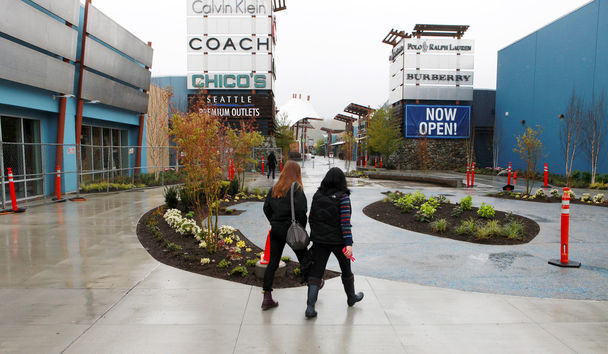 |
| Ken Lambert / The Seattle Times |
The recession brought to a near-standstill all but one segment of shopping-center development in the past few years: the outlet mall.
While developers shelved plans for new full-price shopping centers amid a sharp downturn in U.S. discretionary spending, some stepped up the pace of construction of stores catering to bargain hunters.
Locally, Seattle Premium Outlets on the Tulalip Tribes Reservation soon will unveil a 100,000-square-foot expansion with more than a dozen new stores, including American Eagle Outfitters, Armani Exchange, Clarins, Diane von Furstenberg, Forever 21, MaxStudio and The North Face.
The expansion will give the 8-year-old shopping center half a million square feet and up to 125 stores starting in June. Current tenants Coach, Columbia Sportswear, DKNY, Polo Ralph Lauren and Tommy Bahama also will move to larger space in the new buildings off Interstate 5, near Marysville.
“People are looking for value, and this is what we offer,” said Michele Osgood, the outlet mall’s marketing manager.
Owner Simon Property Group, whose local portfolio also includes Northgate Mall, says its focus for new development is on premium outlets. Indianapolis-based Simon plans to open five outlet malls this year, up from two last year. In total, it has nearly 80 outlet malls in North America and Asia.
Outlet malls originated in the early 1980s as a way for brands to sell surplus stock at lower prices. Today, much of their merchandise is outlet-only, meaning the goods never appear at full-price stores. The change enables retailers to keep a growing number of outlets fully stocked, especially as they use technology to better manage inventory and avoid surpluses.
Analysts say the new frugality, born of the Great Recession, has turned outlet malls into shopping magnets for people who want name-brand merchandise but not at full price.
Sales at outlet stores rose 10 percent for the 12 months that ended in February, according to market-research firm The NPD Group. Meanwhile, non-outlet sales of apparel, shoes and accessories increased only 3 percent.
“The outlet mall continues to grow faster than the traditional retail market,” said Marshal Cohen, chief industry analyst at NPD. “Consumers, because they’re shopping less often, are willing to spend the day at an outlet mall and make it a longer endeavor.”
Seattle Premium Outlets, located about 100 miles from the Canadian border, is popular with shoppers from British Columbia and Alberta, many of whom stay overnight at the nearby Tulalip Resort Casino or Holiday Inn Express, said Osgood.
“The longer they stay here and shop, the more they can take across the border duty-free,” she said.
“So there’s kind of an incentive for them to stay longer.”
But some wonder if a recovering U.S. economy might eventually put a damper on outlet sales.
“In the early 2000s, when the economy got better, outlet shopping plateaued,” said retail analyst Jeff Green. “The question becomes, when the economy gets better, will it plateau again? And I’ve got to believe it might. That’s because it’s the only segment of retail where you’re seeing new development.”
Shopper Evonne Noble, 35, of Seattle, held up a green sleeveless dress Friday during an outing with friends at the Tulalip outlet mall. The dress originally cost $80, but Noble paid $20 at the Banana Republic outlet store.
“I would not come up here without a plan,” she said over lunch at the mall’s food court. “There was this Kate Spade purse I was watching for a year and then I got it here for a few hundred dollars off.
“I hate shopping,” she added. “So I try to do it only a few times a year and be savvy about it.”
Amy Martinez: 206-464-2923 or amartinez@seattletimes.com. On Twitter: @amyemartinez
No comments:
Post a Comment